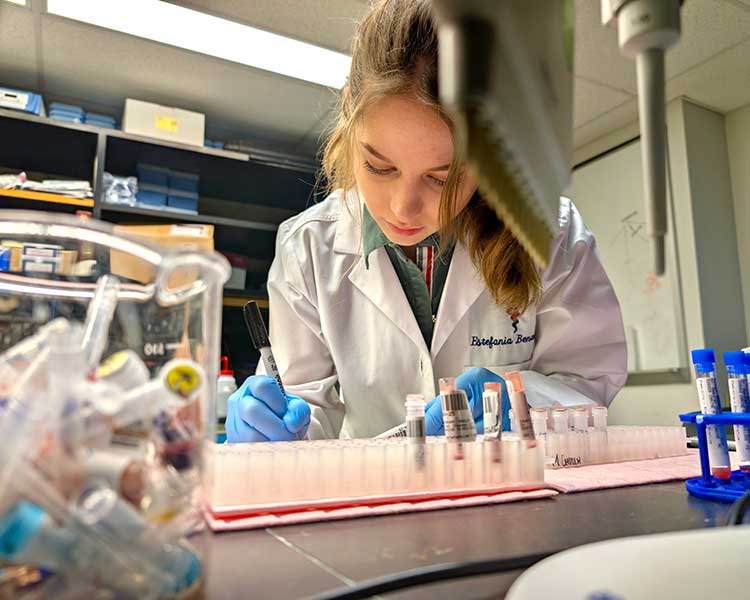VMD | Master of Science in Translational Research
The VMD | Master of Science in Translational Research (MSTR) combined degree is geared toward students who wish to become leaders of translational research. Housed within the ITMAT Education in the Perelman School of Medicine, the MSTR is designed to provide students with in-depth instruction in the fundamental skills, methodology, and principles necessary to become a well-trained translational investigator.
Why Combine a VMD With a Master of Science in Translational Research?
The Master of Science in Translational Research is an ideal, rigorous training program for veterinary students interested in integrating the practice of medicine with research focused on developing new approaches, therapies, devices and diagnostics to treat disorders and disease. Veterinarians with an MSTR are poised to pursue careers in academia, government, and industry — as leaders and collaborators in inspiring medical advances that serve both animals and humans.

Curriculum and Program Structure
The Doctor of Veterinary Medicine | Master of Science in Translational Research (VMD | MSTR) dual-degree program allows students to earn both degrees in five to five and a half years. Students enrolled in the dual degree program must complete the requirements of each individual dual degree program, however, students may count 3 CUs (18 Credits) from the MSTR toward the VMD Degree.
On its own, the MSTR degree is a 12 CU (72 CR) program, consisting of the following courses:
- MTR 600 Introduction to Biostatistics or VSCN 634 Clinical Biostatistics
- MTR 601 Scientific Review Writing
- MTR 602 Proposal Development and Study Design
- MTR 603 Disease Measurement or VSCN 649 Large Animal Diagnostic Imaging
- MTR 604 Scientific and Ethical Conduct or VMED 617 Ethical Issues
- MTR 605 Manuscript Writing
- MTR 999 Lab Units (2 CU)
- MTR 607 and 608 (2 CU) Thesis Credits
- 2 CU Elective Courses
- Research Project and Oral/Written Thesis Defense
- Veterinary students may count the following courses toward their VMD degree (up to 3 CUs):
- MTR 600 Introduction to Biostatistics for VSCN 634 Clinical Biostatistics
- MTR 604 Scientific and Ethical Conduct for VMED 617 Ethical Issues
- Elective Courses
Concentrations
In addition, to the core set of courses, students choose an academic pathway to concentrate in a specific area of translational science:
- Discovery
- Translational Therapeutics and Regulatory Science
- Entrepreneurial Science
- Bioinformatics | Biomedical Informatics
Timing
VMD students begin MSTR coursework in the Summer after Year Three in the VMD Program and devote six terms to MSTR coursework and research. In the Spring of Year Five, they return to primary VMD and complete any remaining clinical requirements to graduate with their VMD|MSTR.
Please note that specific course listings and requirements may evolve over time.
Course Grid
Below is the full-time dual degree proposed timeline/sample course curriculum. Please note that specific course listings and requirements may evolve over time.
| Year | Fall | Spring | Summer |
|---|---|---|---|
| Year 1
Penn Vet | Vet first year curriculum | Vet first year curriculum | Summer Research |
| Year 2 Penn Vet | Vet second year curriculum | Vet second year curriculum | Summer Research (MTR 999?) Begin application to MSTR program |
| Year 3 Penn Vet Perelman School of Medicine | Vet Clinical Rotations VSCN 634 Intro to Biostatistics (to count as credit toward for MTR 600 ) 1 Vet course to count toward MSTR 603: Disease Management | Vet Clinical Rotations | MTR 601: Scientific Writing MTR 602: Proposal Development |
| Year 4
Perelman School of Medicine | MTR 999 Lab MTR Elective 1 | MTR 604: Scientific and Ethical Conduct MTR Elective 2 | MTR 605: Scientific Writing II Defend MSTR Thesis |
| Year 5
Penn Vet Perelman School of Medicine | Vet Clinical Rotations Graduate with VMD | MTR 607: Thesis MTR 608: Thesis |
Application Details
There are two steps to applying to the program:
- Veterinary students must first apply to the VMD+ Dual Degree program in their first or second year of their VMD studies. Applications open each October through December, and students are notified via email once the application is open.
- Students must also apply to the Master of Science in Translational Research Program during the Fall semester of their second year. The combined application form for the MSTR and TL1 training grant for MD | MSTR candidates and instructions for submission, plus application deadlines, are available on the MSTR website.
Financial Aid
All Dual degree students are eligible for scholarships and financial aid as per policies associated with their home schools.
